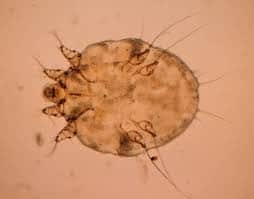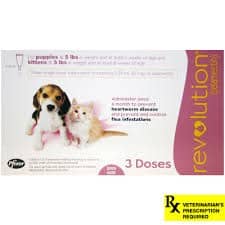
The Organism and How it Lives
Sarcoptic mange is the name for the skin disease caused by infection with the Sarcoptes scabiei mite. Mites are not insects; instead they are more closely related to spiders. They are microscopic and cannot be seen with the naked eye.
Appearance and reaction
The motion of the mite in and on the skin is extremely itchy. Furthermore, burrowed mites and their eggs generate a massive allergic response in the skin that is even itchier.

Some animals have crusts limited to the
ear tips in the beginning stages.
Mites prefer hairless skin and thus the ear flaps, elbows and abdomen are at highest risk for the red, scaly itchy skin that characterizes sarcoptic mange. This pattern of itching is similar to that found with airborne allergies (atopy) as well as with food allergies. Frequently, before attempting to sort out allergies, a veterinarian will simply treat a patient for sarcoptic mange as a precaution. It is easy to be led down the wrong path and pursue allergy aggressively if sarcoptic mange is considered too unusual or unlikely.
As the infection progresses, eventually most of the dog’s body will be involved. Classically, though, the picture begins on the ears (especially the ear margins), elbows, and abdomen.
The term scabies refers to mite infestations by either Sarcoptes scabiei or other closely related mite species. While Sarcoptes scabiei can infect humans and cats, it tends not to persist on these hosts. When people – including some veterinarians – refer to sarcoptic mange or scabies in a cat, they are usually referring to infection by a different mite.
How the Infection is Spread
While mites can live off of a host for days to weeks depending on their life stage, they are only infective in the environment for 36 hours, which means that decontaminating the environment is generally not necessary.
Mite infections on humans are self-limiting (i.e., they go away on their own) as the mite is not able to complete its life cycle on the “wrong” host. However, the condition is extremely itchy while it lasts. The mites are most active where skin is warm, such as in bed or where clothing is snug.
If a pet affected by sarcoptic mange is in the home, it is a good idea to wash any bedding in the washing machine (or replace with new bedding), and wash any collars or harnesses.
Diagnosis
Skin Scraping
Classically, mite infection is diagnosed by scraping the skin surface with a scalpel blade and examining the skin debris under a microscope for mites. If the mite’s presence is confirmed by skin scraping, then you know immediately the cause of the itching; you need not be concerned about allergy possibilities or other diseases and the condition can be addressed with confidence.
Mites can burrow deeper into the skin. So, in some cases mites can be difficult to confirm by skin scraping tests.
Medication Trial
Since negative test results do not fully rule out mite infection, if the symptoms match the infection, a trial drug test is very reasonable. This consists simply of treating for sarcoptic mange and observing for resolution of the signs within 2 to 4 weeks. Treatment is simple and highly successful in most cases so it is fairly easy to rule out sarcoptic mange with a trial course of medication.
Treatment
While sarcoptic mange is can elude detection in some cases via skin scraping, response to treatment may be tried. Options are below:
Ivermectin is the prototype of the aforementioned classical prescription medications used against sarcoptic mange. It is one of the most effective treatments against Sarcoptes scabiei yet it is off-label as far as the FDA is concerned.
Now that there are FDA-approved treatments, ivermectin is not used nearly as much but we include it because the approved treatments are mostly derived from ivermectin and because ivermectin is still commonly used. There are several protocols because of the long activity of this drug in the body.
Typically an injection is given either weekly or every two weeks in one to four doses. There are issues with toxicity in dogs that possess the MDR-1 mutation (usually collie-type breeds). These issues are avoided by using FDA-approved products but for more information, talk with your veterinarian.
Isoxazoline Insecticides (Nexgard®, Simparica®, Bravecto®, Credelio®)
Recently this group of oral (Bravecto is also available as a topical) flea and tick products have come on the parasite control market. They are not FDA approved for treating sarcoptic mange but they turn out to be effective for it anyway. A single treatment at the usual dose is generally adequate to clear sarcoptic mange mites. Now that we have regular flea control products that are also effective on sarcoptic mange, the more classical prescription medications seem to be falling by the wayside.
Selamectin (Revolution®)

Selamectin is an ivermectin derivative marketed for dogs for the control of fleas, ticks, heartworm, ear mites, and sarcoptic mange mites. Normal monthly use of this product should prevent a sarcoptic mange problem but studies show that to clear an infection, for reliable results an extra dose is usually needed after 2 weeks. Because this product is approved for use against sarcoptic mange, the MDR-1 mutation does not come into play.
Moxidectin (Advantage Multi®, Coraxis®)
Moxidectin is yet another ivermectin derivative. It is applied on the skin but is absorbed into the body to act against heartworm, hookworm, roundworm, whipworm, and fleas. In the U.S. this product is not FDA labeled for sarcoptic mange but it is in other countries and should still be effective even though technically it is off-label. In Advantage Multi, it is combined with imidacloprid to also cover fleas while in Coraxis, it is meant as a topically applied dewormer. Moxidectin is not approved for use against sarcoptic mange in the U.S. but is approved for this use in other countries.
Milbemycin Oxime
Milbemycin oxime is approved for heartworm prevention as a monthly oral treatment. Happily, it also has activity against sarcoptic mange and several protocols have been recommended by different dermatologists. This is another medication that you might find recommended. There are many brands available.
Dipping
Here, a mite-killing dip is applied to the pet, usually following a therapeutic shampoo. Mitaban dips (Amitraz) or lime-sulfur dips given weekly are usually effective. Disease typically resolves within one month. Dipping is labor intensive and rarely done any more as the other products are easier and more rapidly effective. We mention dipping since it has been a standard mange treatment for decades prior to the introduction of ivermectin.
In the Meantime
During the time it takes to control the mite infection, the pet will be very itchy. Control of secondary bacterial infections with antibiotics is important. Also, since the body’s reaction to the mite is one of hypersensitivity (essentially an allergic reaction), a cortisone derivative is worthwhile to quell the itchiest symptoms. Ask your veterinarian about whether either such a prescription is appropriate for your pet. As for anti-itch shampoos, rinses, and other forms of itch relief, see itch-relieving ideas for additional suggestions.


